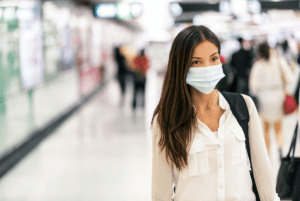9/27/21—As the global community fights the COVID-19 pandemic, there is current debate over steps to prevent the inevitable future pandemics. The topic itself is complex, with focus on researching diseases, the nature of human and wildlife relations and governmental redevelopment. Although the information can be overwhelming, the key points are essential for the world at large to do its part in ensuring it is not hit with another devastating situation like COVID-19.
The relationship between humans and nature is at the core of pandemic prevention. Zoonotic diseases take center stage and are defined as a disease that jumps from animals—wild or domestic—to humans.1 According to a study released by the World Wildlife Fund (WWF) three in four new diseases are zoonotic. As human and wildlife realms become more insidious, through deforestation, land conversion, wildlife trade and meat production, the occurrence of spillover diseases is rising. These zoonotic diseases, having only occurred in animal populations, eventually mutate and travel to humans, leading to mass spread in their newfound hosts.
How do we stop these dangerous practices that put wildlife and humans at risk? Most notable measures include stricter regulations on wildlife trade and less wildlife trade in general, reduced deforestation, and increased funding for scientific monitoring and studying of diseases in animals, which is conducted by “virus hunters.” Creating more sustainable food systems that stop encroachment on nature, increasing investment in wildlife preservation, and alternative means of food production including highly regulated meat production, are also key according to the WWF.
Preparing governing bodies that detect and monitor viruses, like those responsible for international emergency response and enforcement, is crucial. Pandemic surveillance and response are global efforts, meaning it’s time to consider a new global partnership to oversee them.3 While the World Health Organization (WHO) has come under fire for its slow response to COVID-19, there are other complex hierarchies in place that need reform. On an international level, assigning more power to global organizations like WHO, or creating a new global authority for pandemics, is integral. Currently WHO has the International Health Regulations (IHR), a binding international agreement signed with rules related to sharing critical information about epidemics and maintaining core capacities to prevent dangerous disease events.2 However, according to an article from the Council On Foreign Relations, the responsibilities that IHR are assigned fail to prevent, detect, and respond to a pandemic, with programs being under-resourced and lacking capacity to respond to international emergencies.
With this reform and preparation of power, countries should also be provided more incentive to adhere to global directives concerning pandemics. With the COVID-19 pandemic for example, China has been chastised for failing to report findings of COVID-19 in the region in a timely and transparent manner. According to a WHO bulletin, current guidelines on emerging infectious diseases do not consider that when developing countries report outbreaks, they often suffer heavy social and economic consequences. It’s no wonder there is hesitation by developing countries to report findings, for fear of negative impacts. With faster and more transparent reporting, international pandemic response can be utilized faster when time is of the utmost importance.
For the safety of our future, vaccine development and distribution need reform to fight the onslaught of pandemics. More funding to vaccine development ensures that the medical community can develop vaccines, based on the study of animal viruses, and prepare them for possible spillover viruses. According the Scientific American, the ability to rapidly develop and approve vaccines, increasing and globalizing vaccine manufacturing, and a global distribution network and supply chain to get those vaccines out to people, are all needed.4 The distribution of COVID-19 vaccines has been disproportionate to say the least, with wealthier countries having greater access and buying power to get vaccines, while developing countries suffer and lack the means. To truly prevent a future pandemic, the globalization of vaccine development and distribution is integral.
A final key effort for prevention requires community involvement all over the world. Many countries failed to quickly implement safety measures, such as travel restrictions, masking, social distancing, and vigorous contact tracing, as can be done with programs like AlertTrace, and stricter guidelines for communities to follow preventative steps. Providing education to the public on viruses and how they work invites community involvement in the process of prevention. There’s been a lot of misinformation spreading quickly, and more community engagement and communication efforts can help combat this so-called “infodemic.”5
With a multi-layered approach and reform of many complex systems, from meat production to government programs, we can band together to prevent the devastation we’ve seen from the COVID-19 pandemic. AlertTrace is proud to be a part of fighting the spread of infectious disease, with accurate and easy-to-use contact tracing, that can make all the difference in how quickly infectious diseases spread in your organization.
…
1 World Wildlife Fund. (n.d.). A call to stop the next pandemic. WWF. Retrieved September 27, 2021, from https://www.worldwildlife.org/stories/a-call-to-stop-the-next-pandemic.
2 Council on Foreign Relations. (n.d.). Findings | pandemic preparedness: Lessons from covid-19. Council on Foreign Relations. Retrieved September 27, 2021, from https://www.cfr.org/report/pandemic-preparedness-lessons-COVID-19/findings/.
3 Bloomberg. (n.d.). Bloomberg.com. Retrieved September 27, 2021, from https://www.bloomberg.com/news/features/2021-02-03/steps-needed-to-prevent-the-next-pandemic.
4 Berkley, S. (2021, June 23). How to prevent the next pandemic. Scientific American. Retrieved September 27, 2021, from https://www.scientificamerican.com/article/how-to-prevent-the-next-pandemic/.
5 Lee, B. Y. (2021, February 17). How to stop the NEXT Pandemic: Who Director, Bloomberg Offer 7 Directions. Forbes. Retrieved September 27, 2021, from https://www.forbes.com/sites/brucelee/2021/02/15/how-to-stop-the-next-pandemic-who-director-bloomberg-offer-7-directions/?sh=5d0423c775bb.
Cash, R., & Narasimhan, V. (n.d.). Impediments to global surveillance of infectious diseases: consequences of open reporting in a global economy. World Health Organization Bulletin . Retrieved September 2021, from https://www.who.int/bulletin/archives/78%2811%291358.pdf.
Doucleff, M. (2021, April 20). How do we stop the next pandemic? Here’s a new strategy. NPR. Retrieved September 27, 2021, from https://www.npr.org/sections/goatsandsoda/2021/04/20/989074708/anatomy-of-a-spillover-we-failed-to-stop-sars-cov-2-how-do-find-the-next-big-one.
World Health Organization. (n.d.). The best time to prevent the next pandemic is now: Countries join voices for better emergency preparedness. World Health Organization. Retrieved September 27, 2021, from https://www.who.int/news/item/01-10-2020-the-best-time-to-prevent-the-next-pandemic-is-now-countries-join-voices-for-better-emergency-preparedness.
Worldwide Fund for Nature. (2020). COVID 19: URGENT CALL TO PROTECT PEOPLE AND NATURE. Retrieved 2021, from https://c402277. ssl.cf1.rackcdn.com/publications/1348/files/original/FINAL_REPORT_EK-Rev_2X.pdf?1592404724.




